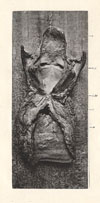


Philadelphia : Lindsay and Blakiston ;
London : J. & A. Churchill, 1876.
Description: [1], 70pp., [4] ; ill., [3] pl., 22 cm.
Photographs: 3 mounted carbon prints of specimens.
Subject: tracheotomy.
A detailed monograph on tracheotomy illustrated with three carbon prints of post-mortem specimens and numerous wood engravings of tubes, beginning with Trousseau's prototypal goose neck and advancing to the patently articulated Durham tube recommended by the author. Thornton provides a comparative analysis of the various canulae as well as colorful case reports of their employment in treating dyspnoea caused by syphilitic and cancer stictures of the trachea, inflammatory laryngitis and epiglottis, the swallowing of foreign bodies, and wound cicatrices including those caused by cut throat and — in the cases involving unattended children — scalds from drinking directly out of the spouts of boiling tea pots.
Throughout the 1800's tracheotomy was a dernier ressort procedure and as late as 1833 only 28 tracheotomies were recorded even though Pierre Bretonneau proved its effectiveness against diphtheritic asphyxiation.* It took the numerous case reports of Bretonneau's student Armand Trousseau who, as chief of clinical medicine at Hôtel-Dieu, versed his surgeon colleagues against their instinctive horror for the procedure. This prejudice against the procedure remained lasted well into the twentieth century. Even Trousseau was too conservative, his 75% mortality rate for over 300 operations was due more to delaying tracheotomy until a point when death was inevitable.
Strangely, Thornton does not acknowledge the work of Trousseau and only provides a brief passage on diphtheria which he introduces with the comment:
There are no cases which more fully reward the practitioner than those belonging to this class, where tracheotomy seems inevitable, and yet where by unremitting attention and watching the operation can be avoided. In these diseases tracheotomy is far less satisfactory than in any other morbid condition in which this operation is admissible, excepting, perhaps, when it is performed for scalding of the larynx; and therefore, if there should be any chance of recovery without resorting to this measure, the chance should be given.
This same quote is used in a book review of Thornton's book which appeared in the Boston Medical and Surgical Journal (January 18, 1877, sans nom) and is introduced by the writer as an admonishment that younger journal readers — and by implication, the less conservative of readers — ought to heed. Although Thornton does not offer the work of Trousseau, he does go on to cite three successful cures reported in a controversial series of articles on tracheotomy and diphtheria published in the British Medical Journal (March and April 1871 issues). The contributing writers included Dr. Bell of Edinburgh, Lawson Tait of Birmingham and Cooper Forster. Thornton also cites Dr. Scoutellen who operated on his six week old daughter, saving her life with a gum-elastic catheter. The rapid industrialization and urbanization of the nineteenth century seeded the scourge of diphtheria and took the lives of millions of children. How many lives would have been saved if doctors were more brazen with the silver canula?



*Bretonneau, Pierre: Des inflammations spéciales du tissu muqueux, et
en particulier de la diphthérite, ou inflammation pelliculaire, connue
sous le nom de croup, d’angine maligne, d’angine gangréneuse, etc.
Published : A Paris, Chez Crevot, Libraire-Éditeur, 1826.
